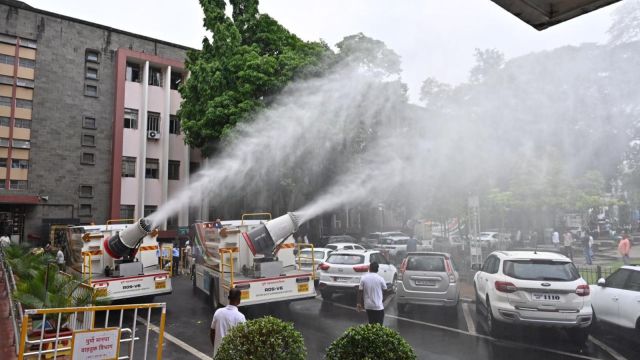Click here to join Express Pune WhatsApp channel and get a curated list of our stories
Pune’s PM10 pollution surges beyond safety limits despite seasonal variation: Report
When contacted, Pune Municipal Corporation's environment department officer Mangesh Dighe said he was not aware of the report
 The report identifies rapid construction, road dust, vehicular congestion, and growing urban sprawl as key contributors to PM10 (Express Photo)
The report identifies rapid construction, road dust, vehicular congestion, and growing urban sprawl as key contributors to PM10 (Express Photo)An analysis of Pune’s air quality by Respirer Living Sciences, a climate-tech startup based on four years of data from the AtlasAQ platform, shows that PM10 concentrations in the city have consistently breached the National Ambient Air Quality Standards (NAAQS) limit of 60 µg/m³—even during summer months when pollution is expected to ease.
Particulate Matter (PM10) pollution refers to airborne particles with a diameter of 10 micrometers or less, which can penetrate deep into the respiratory system, leading to severe health issues, including respiratory diseases, cardiovascular problems, and premature mortality. The AtlasAQ platform was developed to enable validated long-term air quality trend analysis of Indian cities which have the Continuous Ambient Air Quality Monitoring Stations (CAAQMS) network.
According to the report released on Monday, Pune city has shown high seasonal variability, but no sustained improvement across any of the four years. Pune’s citywide PM10 levels spiked from 70.9 µg/m³ in 2021 to 98.9 µg/m³ in 2022, and remained high at 95.9 µg/m³ in 2023, before slightly declining to 86.8 µg/m³ in 2024.
“While this drop may seem encouraging, none of these values meet the NAAQS benchmark, indicating that air quality remains unsafe throughout the year,” Ronak Sutaria, Founder and CEO of Respirer Living Sciences told The Indian Express.
“The narrative around Pune often assumes it’s a clean city—but the data doesn’t support that,” Sutaria said adding that even our so-called ‘clean seasons’ are not actually clean. “PM10 pollution here is ‘unpredictable, persistent, and well above safe limits,” he added.
As per the analysis by Respirer Living Sciences, station-level data reveals extreme intra-year fluctuations. Karve Road showed a dramatic 177.6% rise from 50.0 µg/m³ in 2021 to 138.9 µg/m³ in 2022. Alandi also recorded a spike to 127.3 µg/m³ in 2023 before dropping to 89.0 µg/m³ in 2024. Locations like Transport Nagar, Bhosari, Mhada Colony, and Revenue Colony consistently reported annual averages above 80 µg/m³, while not a single station recorded levels below the national threshold.
The report identifies rapid construction, road dust, vehicular congestion, and growing urban sprawl as key contributors to PM10. It recommends the enforcement of dust control protocols, greater investment in sustainable mobility, and real-time ward-level monitoring to enable more targeted action.
When contacted, Pune Municipal Corporation’s environment department officer Mangesh Dighe said he was not aware of the report.
However, multiple strategies are being taken to spray droplets and settle dust particles to improve air quality levels. “Recently the civic administration introduced the fog cannon machine mounted vehicle to deploy along busy roads to reduce road dust and air pollution,” he said. The fog cannon carrying 6,000 litres of water uses a high-pressure pump to spray water droplets and settle dust particles.
Click here to join Express Pune WhatsApp channel and get a curated list of our stories













